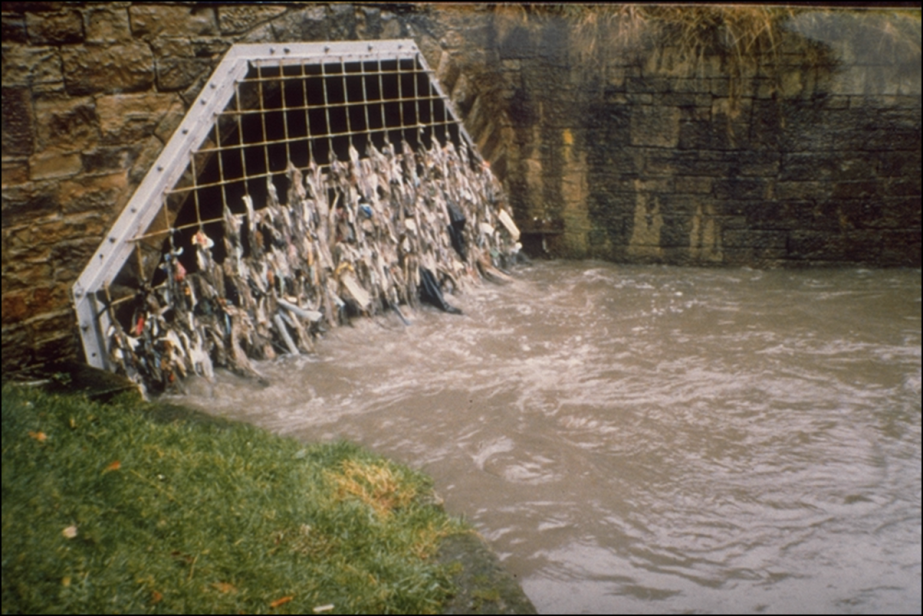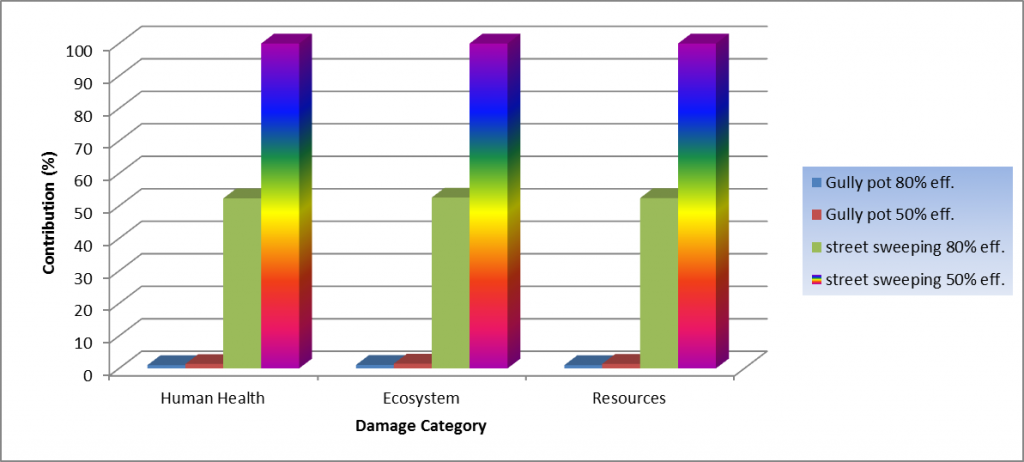
(Source: http://goo.gl/LvXE67)
Sewer overflows are a growing problem in the UK, often causing significant environmental pollution and, in some cases, public health concerns. In the UK, about 70% of the total length of sewerage systems are so-called “combined” sewers, receiving both foul (sewage) and surface water run-off. During rainfall events, surface sediment and litter are carried into these combined sewer systems, mainly through highway gully pots (structures designed to intercept sediment allowing only water through into the sewerage system – see Figure 1). This may contribute to clogging and subsequent overflow.
There are currently over 10,000 known “combined sewer overflows” (CSOs – defined as events where combined sewers overflow due to excess volume and/or blockage) in the UK (Staddon, 2010). Therefore, there is a high probability that road sediment (as well as foul sewage) may escape via overflow discharges during storm conditions, or cause a loss of capacity in the sewer. The amount of sediment entering a sewer depends on local land use, season, rainfall intensity and duration, street sweeping frequency and gully pot size, design, numbers per hectare and emptying routines. The other main sources of sediment into the sewerage network are from households (e.g. laundry and kitchen sinks) and collapsed sewers or leaking pipe joints.

rain event, combined with reduced sewer capacity through sediment infilling,
has meant that foul water is overflowing directly in the natural environment.
The debris caught on the grating is mostly composed of nappies and wet wipes.
Sediment deposition is commonly considered to be one of the major contributory causes of “first foul flush” pollution to natural surface waters (e.g. creeks and rivers) from CSOs. If sewerage networks have become partly or fully blocked by surface sediment and debris, then the initial pulse of rainwater (particularly if heavy), charged with accumulated pollutants including hydrocarbons, salts and landscaping chemicals (applied to roadsides, boulevards and verges), overflows straight into the natural environment. This causes major problems for wastewater system operators, public authorities responsible for roadway maintenance (e.g. blockage and sludge disposal problems) and can lead to significant economic impacts for home and business owners and environmental impacts to receiving waters and surrounding areas.
Sediment management is therefore key to reducing the impact of the first flush pollution. Sediment management generally relies on relatively low technology practices carried out by individuals working for local authorities and industrial establishments. In the UK, the two main practices used to keep road sediment out of the underground drainage system are mechanical road cleaning (using vacuum sweeper machines) and cleaning gully pots.
I have carried out a study using the Life Cycle Assessment (LCA) approach to investigate the problem of road sediment management (particularly grit) in sewer systems for a particular catchment in the UK. I have been studying which of two possible options for dealing with sewer sediment management – mechanical street sweeping or manual gully pot cleaning – is the “greenest” from the perspective of its total lifecycle environmental cost. The study involved undertaking an LCA (using the SimaPro software) of the two options as well as creating a dynamic model of flow through the sewerage system under different rainfall and blockage conditions. Though complex, the dynamic model provided inputs needed for the LCA of sediment management options. The LCA goal is to comparatively evaluate the resource consumption, pollutant emissions and the consequent environmental impacts of the two alternative sediments management techniques.
Street sweeping is routinely carried out in urban areas; it reduces sediment build-up on paved surfaces and is also used to control litter. Consequently, there is a reduction in the amount of sediment that could potentially wash into the sewer system. In developed countries, street sweeping is performed mechanically. In my model, compact vacuum sweepers have been selected as they tend to be used in the UK due to their greater manoeuvring potential. The typical efficiency of a vacuum sweeper has been reported as between 40% and 84%. The machine specification adopted for this study is Swiss-made – the machine and its spare parts are transported from Switzerland – but it is supplied and maintained in the UK. All of these facts are important as LCA analysis tries to account for all environmental costs of a given technology, from “birth” to the “death” as it were.
Gully pots trap sediments, with trapping efficiencies typically varying between 69% and 74% (Osborne et al., 1998). Routine gully pot cleaning is required to prevent sewer systems becoming blocked or partially blocked with sediment and thereby contributing to sewer flooding. When gully pots are full of sediment (as shown in Figure 1B) they have a reduced capacity for retaining additional sediment and may allow it to pass through into the drainage system. In the UK, county, metropolitan or unified councils are responsible for the maintenance of all gullies located on smaller roadways (most “A” roads and lower) and the national Highways Authorities (e.g. Highways England) are responsible for gullies located on larger arterials and highways.
The aim is to clean these regularly, depending on their location and past history of blockage. Cleaning schedules are constantly reviewed. Routine maintenance is required to ensure unblocking and continued efficiency in order to cope with changing climatic conditions, and to remedy inadequate parts of the system (e.g. where underground pipe diameter is reduced and hence its capacity for receiving flow). Estimated cleaning frequencies are once per year on average or when blockages occur. In the UK, circular pots with a diameter of 450mm and a capacity of approximately 90 litres are the most utilised in urban drainage systems.

and compact street sweeper using LCA endpoint approach (Gouda, 2015)
The LCA results show that the highest total environmental impact is incurred by compact street sweepers, specifically during the use stage. The environmental impact from gully pot maintenance was lower; although the highest environmental impact for the gully pot method was incurred during the construction stage. The LCA took into consideration the vacuum tanker required for the gully pot cleaning process. Figure 3 shows the damage category (human health, ecosystem and resources) assessment results for compact street sweeper and gully pot cleaning under two separate efficiency assumptions (50% and 80%). The results indicate that the mechanical street sweeper contributed significantly more to the modelled total environmental cost (“damage”) over its lifecycle, even when it operates at its highest plausible efficiency. By contrast gully pot systems produced far less environmental impact.
The study has demonstrated the utility of life cycle based environmental modelling tools to assess the environmental impact of sediment and litter management in urban environments. Although many might initially think that compact street sweepers represent best environmental practice for reducing the impact of the first foul flush on the aquatic environment, my LCA analysis shows that good design and maintenance of gully pots is by far the “greener” option.
Beyond this particular study, it is clear that LCA can be a powerful tool for supporting greener and more sustainable decision-making by local authorities and water service providers.
References
– Osborne, M., Butler, D., Clarke, P. and Memon, F. (1998). Management of gully pots for improved runoff quality. CIRIA Report No. 183, London.
– Staddon, C. (2010) Water resources, stormwater, wastewater, combined sewer overflow. In: Cohen, N., ed. (2010) Green Cities: An A-Z Guide. (Vol. 4) SAGE Publishing. ISBN 9781412996822
